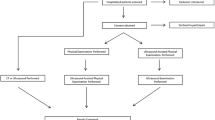Abstract
Objective: To determine the reliability and validity of various physical diagnostic techniques (including three methods of palpation and three methods of percussion) in detecting ultrasonographically identified splenomegaly.
Design: Prospective, double-blind study.
Setting: University hospital.
Patients: Twenty-seven hospitalized male patients with suspected human immunodeficiency virus (HIV) infection.
Interventions: Three methods of palpation (bimanual, ballottement, and palpation from above) and three methods of percussion (as described by Nixon, Castell, and Barkun et al.) were performed on each patient by eight examiners. Splenic ultrasonography was performed within 96 hours of admission.
Measurements and main results: The prevalence of splenomegaly by ultrasonography (defined as a spleen ≥ 13 cm on the longitudinal scan) in this population was 33.3%. The sensitivity and specificity of each method of palpation and percussion varied by examiner. The ranges of sensitivity across examiners for the three methods of palpation and the three methods of percussion were 0%–64.3% and 7.7%–75%, respectively. The ranges of specificity across examiners for the three methods of palpation and the three methods of percussion were 50%–100% and 60%–100%, respectively. Likelihood ratios pooled across observers revealed that for palpation, palpation from above, and percussion, Castell’s method had the highest likelihood ratios [LR=2.66 and 1.97, respectively; 95% CI=1.52–4.64 and 1.22–3.19, respectively]. A combination of tests (either palpation or percussion) increased the diagnostic accuracy.
Conclusion: Physical diagnostic techniques for the detection of splenomegaly are relatively insensitive but specific. In this study there was high interobserver variability, which did not appear to be associated to the level of experience. Combining tests increases diagnostic accuracy.
Similar content being viewed by others
References
Halpern S, Coel M, Ashburn W, et al. Correlation of liver and spleen size. Determinations by nuclear medicine studies and physical examination. Arch Intern Med. 1974;134:123–4.
Sullivan S, Williams R. Reliability of clinical techniques for detecting splenic enlargement. Br Med J. 1976;30:1043–4.
Holzbach RT, Clark RE, Shipley RA, Kent WB, Lindsay GE. Evaluation of spleen size by radioactive scanning. J Lab Clin Med. 1962;60:902–13.
Barkun AN, Camus M, Green L. The bedside assessment of splenic enlargement. Am J Med. 1991;91:512–8.
Barkun AN, Camus M, Meagher T, et al. Splenic enlargement and Traube’s space: how useful is percussion? Am J Med. 1989;87:562–6.
Ransohoff DF, Feinstein AR. Problems of spectrum and bias in evaluating the efficacy of diagnostic tests. N Engl J Med. 1978;299:926–30.
Yang J, Rickman LS, Bosser SK. The clinical diagnosis of splenomegaly. West J Med. 1991;155(Jul):47–52.
Kardel T, Holm HH, Rasmussen SN, Mortensen T. Ultrasonic determination of liver and spleen volumes. Scand J Clin Lab Invest. 1971;27:123–8.
Koga T, Morikawa Y. Ultrasonic determination of the splenic size and its clinical usefulness in various liver diseases. Radiology. 1975;115:1073–7.
Leopold GR, Asher WM. Fundamentals of abdominal and pelvic ultrasound. Philadelphia: W. B. Saunders, 1975;77–81.
Welch K, Finkbeiner W, Alpers CE, et al. Autopsy findings in the acquired immune deficiency syndrome. JAMA. 1984;252:1152–9.
Abrams DI, Lewis BJ, Beckstead JH, Casavant CA, Drew WL. Pesistent diffuse lymphadenopathy in homosexual men: endpoint or prodrome? Ann Intern Med. 1984;100:801–8.
Metroka CE, Cunningham-Rundles S, Pollack MS, et al. Generalized lymphadenopathy in homosexual men. Ann Intern Med. 1983;99:585–91.
Nixon RK. The detection of splenomegaly by percussion. N Engl J Med. 1954;250:166–7.
Castell DO. The spleen percussion sign, a useful diagnostic technique. Ann Intern Med. 1967;67:1265–7.
DeGowin EL, DeGowin RL. Bedside physical examination, 5th ed. New York: MacMillan, 1987;498–510.
National Institutes of Health Consensus Development Conference Statement. Health implications of obesity. Ann Intern Med. 1985;103:1073–7.
Siegel S, Castellan NJ. Nonparametric statistics for the behavioral sciences, 2nd ed. New York: McGraw Hill, 1988;262–2.
Clain A, ed. Hamilton Bailey’s demonstrations of physical signs in clinical surgery, 16th ed. London: John Wright & Sons, 1980;236–7.
Bates B. Guide to physical examination and history taking, 4th ed. Philadelphia: J. B. Lippincott, 1987;338–44.
Singer J. Value of clinical signs in diagnosis of deep vein thrombosis. Lancet. 1980;1:1186.
McIntyre R, Ebaugh FG. Palpable spleens in college freshmen. Ann Intern Med. 1967;66:301–6.
Author information
Authors and Affiliations
Additional information
Supported by the California Universitywide AIDS Research Program and the California Collaborative Treatment Group Grant #R90-CC86SD, the Agency for Health Care Policy and Research Grant #HS06211-03, and the Office of Vice-Chancellor of Undergraduate Affairs, University of California, San Diego.
Rights and permissions
About this article
Cite this article
Tamayo, S.G., Rickman, L.S., Mathews, W.C. et al. Examiner dependence on physical diagnostic tests for the detection of splenomegaly. J Gen Intern Med 8, 69–75 (1993). https://doi.org/10.1007/BF02599986
Issue Date:
DOI: https://doi.org/10.1007/BF02599986




